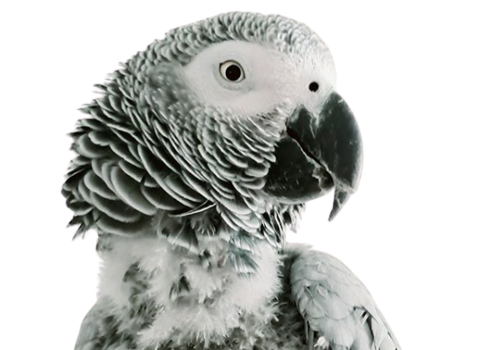One of the most common questions that prospective African Grey owners ask is whether they should get a male or female bird. In this post, we will explore the differences between male and female African Grey parrots and how to determine their gender.
Is your African Grey a boy or a girl? If you’re unsure about your parrot’s gender, discover the subtle signs to look for and learn about the most reliable method to find out! Dive into our detailed guide at TiktokParrot.com for everything you need to know.
Determine Gender of African Grey Parrots
Determining the gender of African grey parrots can be challenging as both male and female birds have similar physical characteristics. However, there are a few subtle differences that can help determine the gender of the bird.
Physical Differences
Generally, male grey parrots are slightly larger than females. Males also have broader heads and thicker necks than females. On the other hand, female grey parrots have a smaller head, a slender neck, and a narrower pelvis than males.
Another physical difference between male and female grey parrots is in their eye color. Generally, males have a lighter eye color, and females have a darker eye color. However, it is worth noting that eye color can vary among individual birds and is not a reliable way to determine gender.
Some owners and breeders of African greys say it’s easy to discern the subtle differences between males and females once they reach an age of 18 months or more, or after their first molt.
A male African grey’s tail will remain solid red, while a female’s red tail feathers become tipped with silver. The undersides of a male’s wings become dark, while a female’s remain light.
Other subtle differences between the male and female African grey include a more slender neck and narrower head in the female, and a rounded eye patch. The male eye patch becomes somewhat pointed behind the eye.
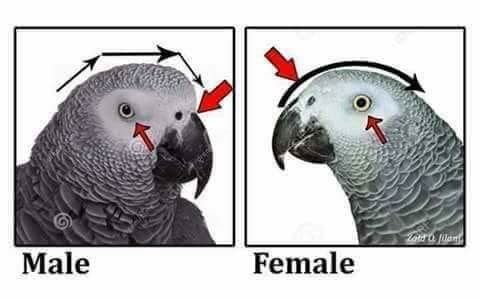
There are slight differences in body type and size between males and females.
First consider your bird’s general body type to get a gauge of whether your bird is more likely male or female. From there, you can look at more subtle physical characteristics.
[1] Males are usually 12-14 inches (30-35.5 cm) in height. Females are generally somewhat shorter than this.
[2] The body of a male African Grey is somewhat round, while females tend to be more slender. Males heads tend to be small and flat, and their necks are shorter. Females tend to have longer necks, with larger, rounder heads.
Examine coloration. Males typically have a darker and more uniform color than females. Females, on the other hand, have a gradual light-to-dark coloration from their neck to their belly.
[3] This technique should only be considered in birds older than 18 months. A chick’s feathers are still growing, so the color will change with age.
Examine tail feathers. Traditionally, male Greys have darker tail feather colors than females. You need to check what are called the “ventral feathers.” These are a set of about 10 feathers found directly under the bird’s tail. You can pick up your African Grey and gently flip him or her over to examine the feathers.
[4] Females will have ventral feathers that are edged in a shade of gray. Males will have ventral feathers that are solid red. There may be a small white hairline on male feathers. Keep in mind, this test is not accurate for young parrots. You cannot rely on tail feathers to determine sex unless your grey is 18 months of age or older.
Generally, there are no reliable external sex differences. Experienced breeders may recognize subtle size and color variations between the sexes of their own breeding birds, but this is very subjective and not a reliable way to determine gender.
Behavioral Differences
Apart from physical differences, African grey parrots also exhibit behavioral differences that can help determine their gender.
For example, male grey parrots are generally more vocal and outgoing than females. Males are also more likely to imitate human speech and other sounds. Female Grey parrots, on the other hand, tend to be more reserved and less vocal than males.
In short words, if you are still curious to know about your grey, below are the most common six signs which may help you to determine the gender of your grey parrot by the appearance;
| Male African Grey Parrot | Female African Grey Parrot |
| 1- Male African Grey Parrots are usually larger. They are almost 12-14 inches in height. | 1- Female African Grey Parrots are usually smaller and their height is less than 12-14 inches. |
| 2- Male African Grey Parrots have smaller neck than female. Their head is small and flattered. | 2- Female African Grey Parrots have longer neck. They have larger and rounded head. |
| 3- The body of male African grey parrot is somewhat rounded. | 3- The body of female African Grey Parrot is elliptical and slender. |
| 4- The tail feathers of the male African Grey Parrot will be fully red in color. | 4- The female African Grey parrot’s tail feathers are also red, but they will possess silver hues. |
| 5- The underside of feathers the Male African Grey Parrots will be dark Gray. | 5- The underside of feathers the Female African Grey Parrots will be light Gray. |
| 6- Male African Grey parrots have eye patches that have pointed ends. | 6- Female African Grey parrots have eye patches that are rounded. |
As the saying goes, a picture is worth a thousand words. I won’t have to type so much if we take a look at these examples.
As per the below image under-wing shades of Grey: It is often best to “see” the different shades of gray by doing just a quick glance. Try doing this while standing 5 to 10 feet away from the bird, while the bird is on top of its cage or play stand, just flapping its wings.
If you study, or stare too hard at the under-wing, it is easy to second-guess yourself, and see three shades of gray. In males it should appear to be two shades of gray. In females there should appear to be three shades.
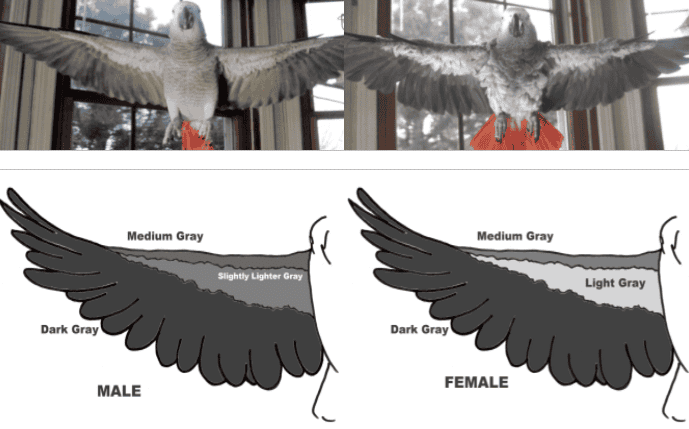
As per the below image under tail coverts: By far the quickest and most popular method for visual sexing is looking at the under-tail coverts. The amount of gray edging can vary widely, with some birds having almost no gray edging at all. In that event, use some of the other methods listed below. When using this method, there are generally 10 feathers that make up the “V” shape under the tail. The individual feathers in this grouping will be solid red on the males. They’ll be edged in gray on females. This does NOT work on babies.

As per the below image tail length of grey: This is an easy one. Male wings fall short of the tail tip, while female’s wing tips will normally touch or fall a bit beyond the tip of the tail.
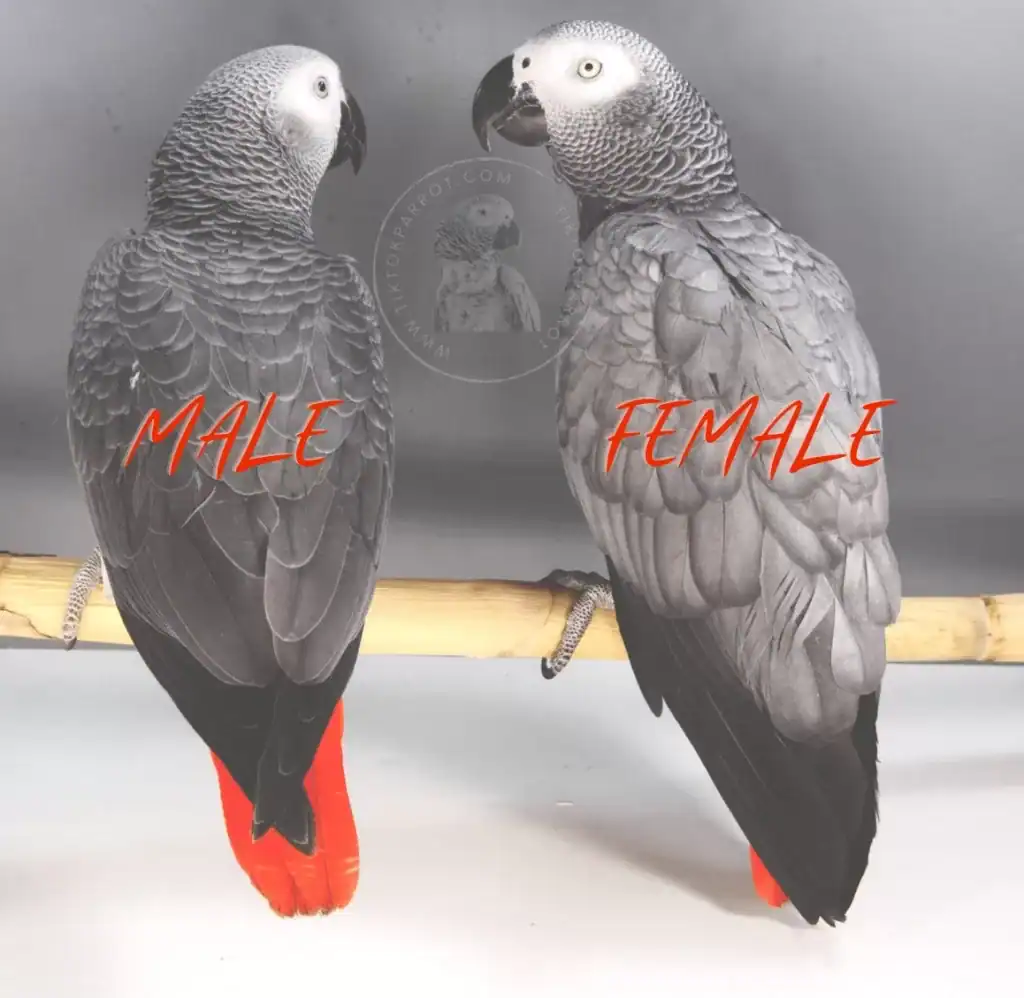
As per the below image, from feathers to coverts: While standing away from the bird and looking at the side of the bird, notice the dark primary feathers in relation to the primary coverts. In males the contrast is blended or smudgy-looking. In females there is a more obvious contrast where the primary coverts overlap the primary flight feathers.

As per the below image, front wing, closed contrast: This one is a bit harder than the others. While the African grey is perched, facing you, there is a sliver of feathers peeking out from under the wing. In males this sliver of feathers is blended. In females the contrast is more obvious. Can sometimes work with babies.
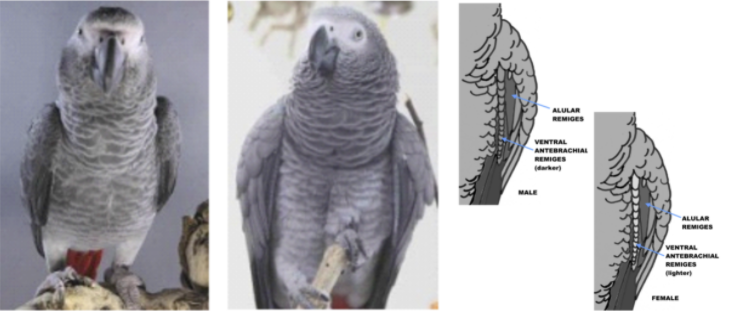
DNA Testing
The most reliable way to determine the gender of an African Grey Parrot is through DNA testing. This involves taking a blood sample from the bird and sending it to a laboratory for analysis. The laboratory will then analyze the DNA in the sample to determine the bird’s gender. DNA testing is highly accurate and can determine gender with 99.9% accuracy.
Physically, we can not be 100% sure to determine sex, although there are some characteristics that tend differ slightly between males and females. You should contact an avian veterinarian or have a DNA test conducted if you want a definitive answer. This is the only way to be certain of the sex of your African Grey parrot.
My Closing Thoughts
Overall, whether you choose a male or female grey parrot as your pet is a matter of personal preference. While physical and behavioral differences may be helpful in determining gender, DNA testing is the most reliable method.
Ultimately, what’s most important is providing your grey with a loving and nurturing environment to thrive. With their intelligence and charming personalities, these birds can bring a great deal of joy and companionship to their owners. By taking the time to learn about their unique needs and behaviors, you can ensure a long and happy life for your African grey parrot.
If you found this blog helpful, It would be great if you could share it with your family and friends who might find it useful as well.
For more useful content about African Grey parrots, you can subscribe my site with your email to get notification upon publishing a new blog, the subscribe box you can see on the right side of this page. Also if you get an alert on your web browser while browsing my site, allow it and that will also give you an alert whenever I publish a new blog. 🙂
Check out my eBook “The Grey Area”
You can watch the video also to get a clear picture about your African grey’s gender!
You might like reading this:
Types of African Grey Parrots
African Grey Parrot Price & Owning Cost
The Surprising Benefits of Owning an African Grey Parrot
African Grey Parrots as Pets, The Pros and Cons of Owning One
What To Do If Your Parrot Is Choking, something stuck in the throat?
Are African Grey Parrots Smarter Than Dogs?
Stay safe and much love !


